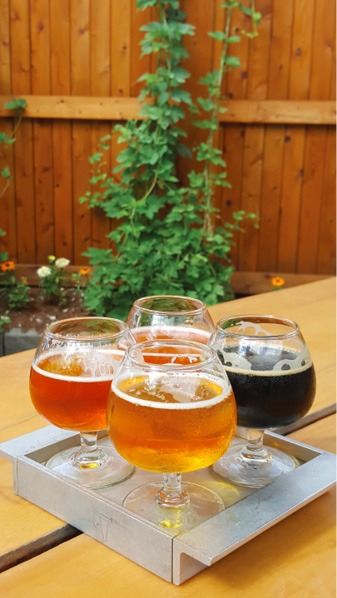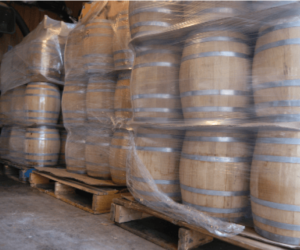Nanobrewing: The Business Case for the Nano

Most nanobreweries are more akin to a brewpub than the traditional craft brewery. Only smaller, and often- times without a kitchen, servers, high overhead, long hours of operation, or the expensive downtown location. Nanobreweries are all about the beer, and thanks to legislative changes that allow brewers to sell beer in a bar without a restaurant (something that most states required when the early brewpub laws were enacted), nanobreweries are not always a restaurant. This allows the nanobrewery business owner to envision their business more like a boutique clothing store than a full-service department store. In other words, the nanobrewery has a much lower barrier to entry.
Nanobrewery owners have developed multiple business models that work. Examples include the small BBQ/pizza/hamburger joint with very small brewing facility tucked in a corner and often invisible to patrons (think retro brewpub circa 1984), the killer 2-barrel (BBL) homebrew system located in a funky garage with beach bar, pop-up sun shade that opens for service from 5-7 p.m three days a week and only serves beer to clients in the know, to the 300 sq. ft., light industrial space-turned-brewery that serves beer in a small tasting room adjacent to the local food truck pen where patrons can buy beer from the nanobrewery and food from their favorite food truck. The commonalities of these business models are lower overhead, lower capital investment, smaller footprint, small labor force, and lower barriers to entry in comparison to a 10,000 sq. ft. brewery-restaurant or 5,000 BBL/year packaging brewery with kegging, canning, and/or bottling equipment.
NANO AND LARGE-SCALE HOMEBREWING
Nanobrewing equipment has much more in common with a homebrewing set-up than most of the 10-20 BBL systems used in brewpubs and smaller packaging breweries. Similarities with homebrewing equipment, equipment availability, and relative simplicity of the business model (no elaborate restaurant, little to no beer packaging, and no distribution sales network), are attracting many homebrewers to nanobrewing. The remainder of this first column on nanobrewing will compare nanobrewing methods to the typical commercial brewing dynamic.
MILLING
Truth be told, milling is something that may be left to your malt supplier because the cost of a mill and the attention required for proper and consistent operation is something that may take 4-5 years to pay back. Most suppliers add about $0.05 to the cost of a pound of malt to cover milling. When the malt is milled, the original malt bag is typically re-used and sewn closed just like the original bag. As long as the malt is stored in a dry place and used within a couple of months, there are no real storage issues with pre-milled malt.
Buying pre-milled malt allows the nanobrewer to save space on a mill, and on equipment upkeep. Plus, the term “mill room” can send up red flags to building inspectors about dust explosions, and the decision to have a mill in the brewery may cost more than just the mill.
Nanobrewing equipment has much more in common with a homebrewing set-up than most of the 10-20 BBL systems used in brewpubs and smaller packaging breweries.
If a mill is included in the nanobrewery, it needs to be durable, reliable, and relatively trouble free. The milling operation is not the most important part of the brewing process for small brewers, but if the mill is unreliable it can put a hitch in the brew day before the mash begins.
WORT PRODUCTION
Most craft breweries with brewhouses in the 10+ BBL size range use either infusion mash or stirred mash brewhouses for wort production. Infusion mashing is usually defined as isothermal mashing where the mashing process and wort separation process occur in the mash tun. Stirred mashes usually occur in a mash mixer, and usually are transferred to a lauter tun for wort separation. Wort is boiled in a kettle, and the whirlpool process can be carried out in a separate whirlpool or the brew kettle.
Most infusion mash brewhouses are based on two main vessels; the mash tun and the kettle/whirlpool. Stirred mash brewhouses typically have at least three vessels, and sometimes as many as six. The simplest set up is a combination mash mixer/kettle, lauter tun, and whirlpool (the mash mixer/kettle has a mixer inside and cannot be efficiently be a whirlpool vessel), and the fussiest stirred mash system includes mash mixer, decoction kettle, lauter tun, wort receiver, kettle, and whirlpool. Note that hot liquor/ water tanks are not included in this brewhouse vessel count.
This is where the nanobrewery is much more similar to homebrewing than larger, even marginally larger, craft breweries. Two-vessel infusion systems are quite common, but so are brew-in-a-bag (BIAB), recirculating infusion mash system (RIMS), heat-exchanging recirculating mash system (HERMS), and extract-based brewhouses. Common too are gas-fired and electrically heated brew kettles, which have essentially been replaced by steam-heated kettles in the 10+ BBL brewhouse.
The take away message here is that the cost and complexity of the nanobrewery brewhouse greatly reduces equipment cost in comparison to larger brewhouses. This distinction is especially true when comparing the cost of a steam-heated brewhouse to a gas-fired system, because the cost associated with steam (boiler, steam, and condensate piping, and gas line to boiler) is eliminated.
WATER STORAGE AND WORT COOLING
Most brewhouses, even small kits, use a hot water tank to store hot water generated during wort cooling. This makes perfect sense when brewing frequently because the hot water generated during wort cooling can be used in the next batch for mashing and sparging. And if the system is properly designed for the typical brew type (ale or lager), the hot water generated from wort cooling is just the right amount of water required for the next batch.
The most common type of wort chiller used in the modern brewery, regardless of size, is a gasketed plate heat exchanger or PHE (versus brazed PHEs). A single-stage PHE (just one type of coolant) using ~64 ˚F (18 ˚C) water can knock the wort temperature down to about 68 ˚F (20 ˚C) using about 1.4 volumes of water per volume of wort. Some lager brewers use chilled water for all of their wort cooling needs, and others use a combination of water and glycol in a two-stage heat exchanger for wort cooling. While these methods are the same with breweries of all sizes, a major distinction with nanobreweries is the water tank situation.
The best wort cooling system for the nanobrewery is one that is efficient, cost-effective, and totally cleanable.
Ambient or cold water tanks (depending on groundwater temperature and the type of beer being brewed) are usually found in breweries because the flow rate of water required during wort cooling is usually higher than what the water supply is able to handle. These surge tanks can be filled slowly and emptied quickly for wort cooling. Nanobreweries usually do not need an ambient or cold water storage tank. So this equipment can be crossed off of the list.
What about hot water? Hot water recovery tanks only make sense when the recovered water can be quickly re-used, and are always insulated to prevent rapid cooling. Since most nanobrewers are not brewing more than a few batches per week, the investment in insulated hot water tanks may not be justifiable. And if the investment is justifiable, re-purposed, home, hot water heaters are a great option to insulated stainless steel vessels.
The best wort cooling system for the nanobrewery is one that is efficient, cost-effective, and totally cleanable. This is where nanobrewing should be more aligned with other craft brewing systems because a wort cooler that can be opened for periodic inspection (gasketed PHE instead of brazed PHE) is important.
FERMENTATION AND AGING
Walk into your favorite brewpub or packaging brewery and you are likely to see cylindroconical fermentation vessels (aka unitanks) with individual tank cooling. Unitanks are awesome vessels because beer can be fermented, carbonated, and aged in the same vessel. They also permit easy yeast harvesting, are conveniently dry-hopped, and can be cleaned-in-place (CIP). But they are also expensive to purchase and require glycol for cooling. Most homebrewers are not using unitanks for fermentation and aging.
All options are open for the nanobrewer. Old school open fermenters or carboys combined with pressure-rated aging vessels, fermentation and aging in carboys followed by carbonation in kegs, open fermentation in buckets followed by barrel aging and bottle condition, the sky is the limit. The limited production and small batch sizes of the nanobrewery really opens up the possibility of using dedicated walk-in coolers for fermentation and aging. Larger brewers cannot easily move full tanks of beer from one environment to another, but the nanobrewer can do this with ease.
More on this deep topic will be covered in the future, but the thing to consider is that expensive and elaborate unitanks are not required for nanobrewing. And nanobrewers have much more flexibility when it comes to using different yeast strains. Indeed, using a fresh pitch of dried or liquid yeast for each brew totally eliminates the need to harvest yeast from fermentation vessels, making simple flat-bottomed containers attractive fermenters.
PACKAGING AND DISPENSE
Anyone who has ever considered opening a packaging brewery knows that packaging can be extremely expensive and intimidating to imagine operating. Nanobreweries typically sell their beer through their own taps, so the only packaging that is required are kegs.
This is where I will give some of my own personal opinions about the business model . . . nanobreweries should strive to sell 100% of their production at their own facility. Seriously, forget about distribution; the US beer market is extremely crowded and looking to sell beer through distribution channels does not make financial sense for the nanobrewer. I will come back to this topic in future columns, but think again if you want to get your beer into local bars because the reduction in margin and added headaches probably do not pencil out. And if you believe this is effective marketing, look at how loyal multi-tap bars are to the beers they serve.
The simplest and least expensive route is to keg all of the beer, store in a walk-in cooler that may also double as lagering cellar and hop storage room, and serve through taps that go right through the wall of the cooler. Easy-peasy, no fuss-no muss, and super flexible. Looking for more? Sell beer to-go in growlers or crowlers to supplement sales. Again, my view is to strive for 100% of sales as draft because of margins; growlers and crowlers typically are sold at a discount in comparison to draft beer consumed on-site, so be careful about this decision.
Doing sours and strong beers? This is where limited bottling may make sense if you are bottle conditioning part of your production to sell as a super-premium. Just make sure you fully understand your costing and prevent margin erosion by proper pricing.
The take home message about packaging and dispense is that this is where the rubber meets the road and where revenue is generated. Revenue is the one thing that totally makes nanobrewing different from homebrewing. This is a business and it should not lose money. Nanobrewery ownership should be fun and rewarding, and if the nanobrewery owner can do these things while getting paid for their efforts, the model sounds like a good deal!


